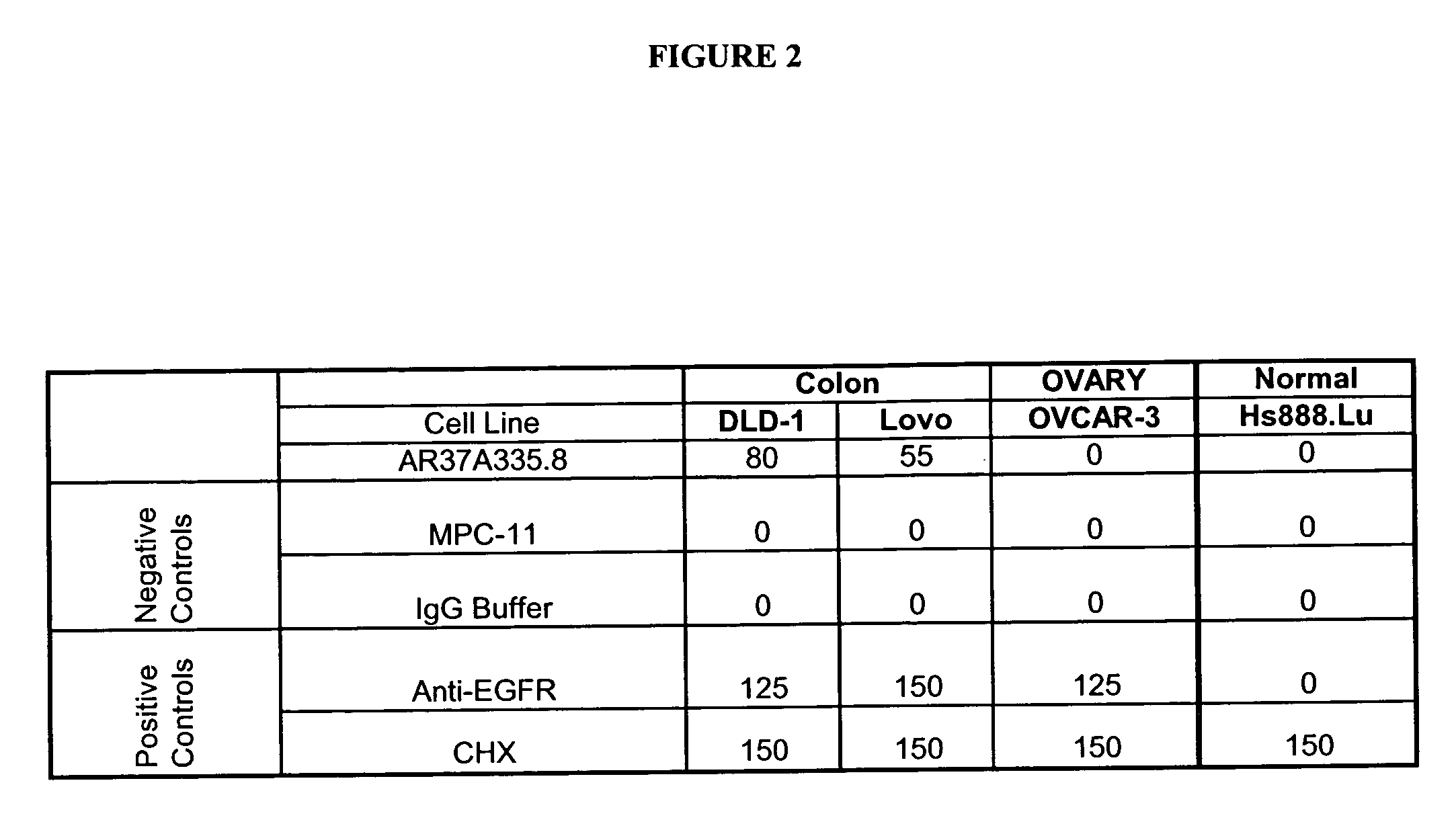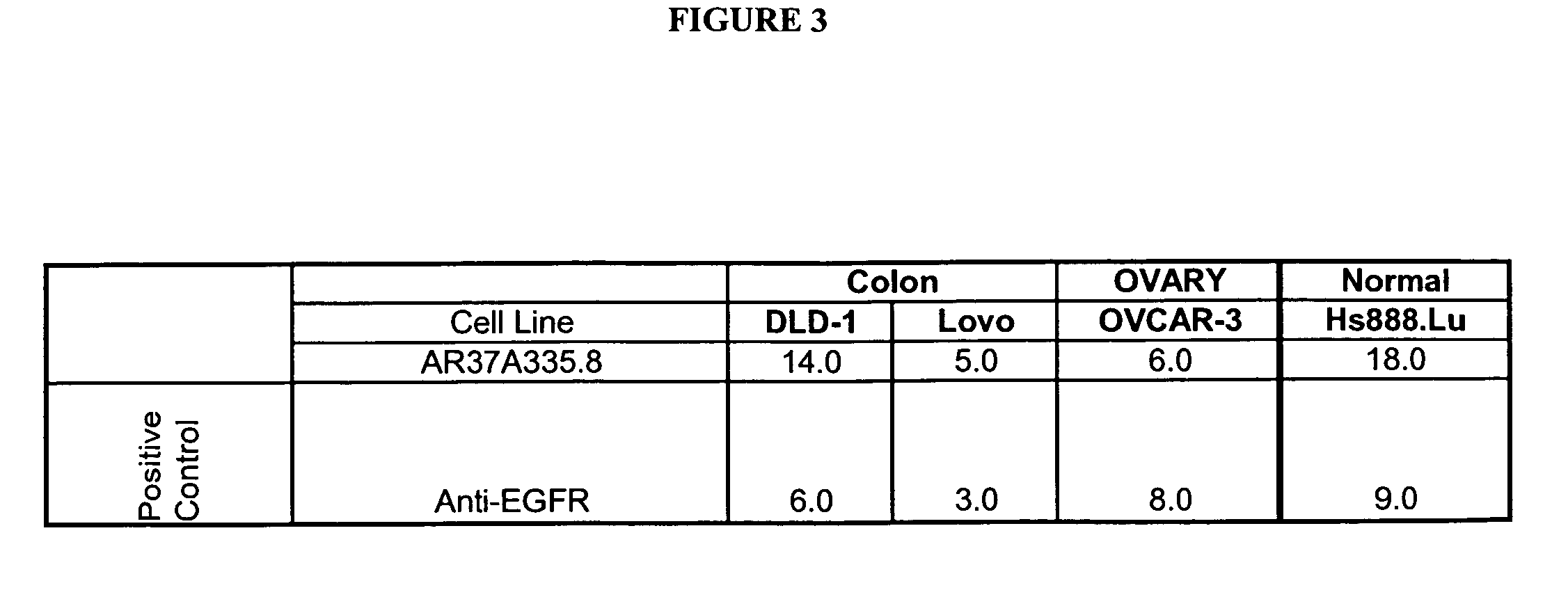Cytotoxicity mediation of cells evidencing surface expression of CD44
a cytotoxicity and surface expression technology, applied in the field of cancer diagnosis and treatment, can solve the problems of insufficient evidence, inconsistent findings, and increased likelihood of tumor invasiveness and induction of angiogenesis through the ecm
- Summary
- Abstract
- Description
- Claims
- Application Information
AI Technical Summary
Benefits of technology
Problems solved by technology
Method used
Image
Examples
example 1
Hybridoma Production—Hybridoma Cell Line AR37A335.8
[0188] The hybridoma cell line AR37A335.8 was deposited, in accordance with the Budapest Treaty, with the International Depository Authority of Canada (IDAC), Bureau of Microbiology, Health Canada, 1015 Arlington Street, Winnipeg, Manitoba, Canada, R3E 3R2, on Jan. 28, 2004, under Accession Number 280104-06. In accordance with 37 CFR 1.808, the depositors assure that all restrictions imposed on the availability to the public of the deposited materials will be irrevocably removed upon the granting of a patent.
[0189] To produce the hybridoma that produces the anti-cancer antibody AR37A335.8, a fresh single cell suspension of the PC-3 prostate cancer cell line that had been grown as a solid tumor in SCID mice, was prepared in PBS. IMMUNEASY™ (Qiagen, Venlo, Netherlands) adjuvant was prepared for use by gentle mixing. Five to seven week old BALB / c mice were immunized by injecting subcutaneously, 2 million cells in 50 microliters of t...
example 2
Antibody Production:
[0194] AR37A335.8 monoclonal antibody was produced by culturing the hybridoma in CL-1000 flasks (BD Biosciences, Oakville, ON) with collections and reseeding occurring twice / week. Standard antibody purification procedures with Protein G Sepharose 4 Fast Flow (Amersham Biosciences, Baie d'Urfé, QC) were followed. It is within the scope of this invention to utilize monoclonal antibodies that are human, de-immunized, humanized, chimerized or murine.
[0195] AR37A335.8 was compared to a number of both positive (anti-EGFR (C225, IgG1, kappa, 5 micrograms / mL, Cedarlane, Hornby, ON), cycloheximide (CHX, 0.5 micromolar, Sigma, Oakville, ON), and NaN3 (0.1%, Sigma, Oakville, ON)) and negative (MPC-11 (antigenic specificity unknown, IgG2b, kappa, 20 micrograms / mL, BD Biosciences, Oakville, ON) controls as well as a buffer diluent control in a cytotoxicity assay (FIG. 2). Colon (DLD-1 and Lovo) and ovarian (OVCAR-3) cancer, and non-cancer lung (Hs888.Lu) cell lines were te...
example 3
In vivo Tumor Experiments with MDA-MB-231 Cells
[0198] With reference to FIGS. 5 and 6, 4 to 6 week old female SCID mice were implanted with 5 million human breast cancer cells (MDA-MB-231) in 100 microliters saline injected subcutaneously in the scruff of the neck. The mice were randomly divided into 2 treatment groups of 5. On the day after implantation, 20 mg / kg of AR37A335.8 test antibody or buffer control was administered intraperitoneally to each cohort in a volume of 300 microliters after dilution from the stock concentration with a diluent that contained 2.7 mM KCl, 1 mM KH2PO4, 137 mM NaCl and 20 mM Na2HPO4. The antibody and control samples were then administered once per week for the duration of the study, a total of 8 doses, in the same fashion. Tumor growth was measured about every seventh day with calipers. Body weights of the animals were recorded once per week for the duration of the study. At the end of the study all animals were euthanized according to CCAC guideli...
PUM
| Property | Measurement | Unit |
|---|---|---|
| median time | aaaaa | aaaaa |
| median time | aaaaa | aaaaa |
| median time | aaaaa | aaaaa |
Abstract
Description
Claims
Application Information
 Login to View More
Login to View More - R&D
- Intellectual Property
- Life Sciences
- Materials
- Tech Scout
- Unparalleled Data Quality
- Higher Quality Content
- 60% Fewer Hallucinations
Browse by: Latest US Patents, China's latest patents, Technical Efficacy Thesaurus, Application Domain, Technology Topic, Popular Technical Reports.
© 2025 PatSnap. All rights reserved.Legal|Privacy policy|Modern Slavery Act Transparency Statement|Sitemap|About US| Contact US: help@patsnap.com



